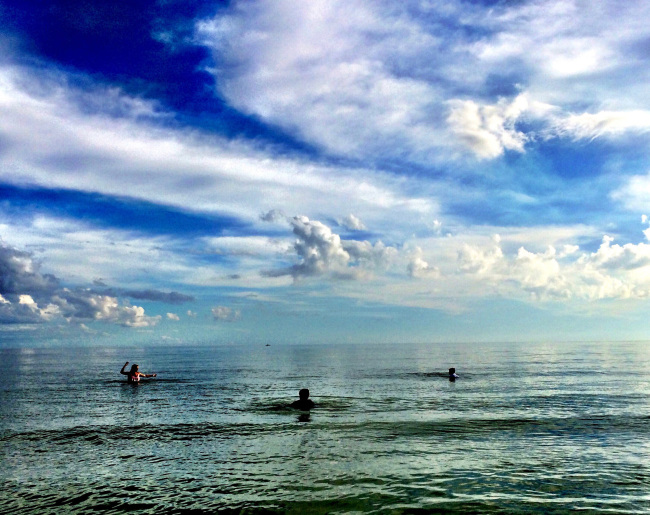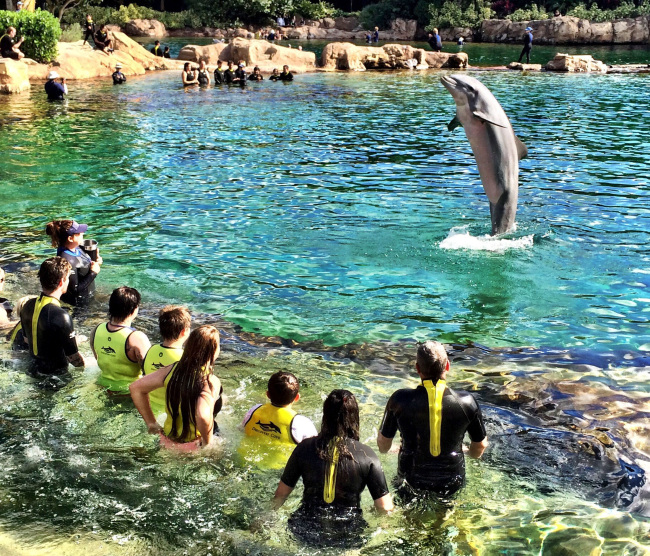From Orlando to Sanibel Island, finding magic in the Florida kingdom
By Yoon Min-sikPublished : Feb. 17, 2017 - 17:46
For more than a moment, I found magic in Orlando.
As I stood in the glow of Cinderella’s Castle on a crisp November night, fireworks filled the sky and the songs of childhood pealed when Tinker Bell, a human sprite in bright green tights and Day-Glo wings, popped out of a turret and zip-lined toward Tomorrowland like a cartoonish flare.
Thousands of stunned park-goers clapped furiously as the light show dimmed -- a perfect end to my first day in Florida with two nephews, a great-niece and Grandma Mary.
I’d promised the kids a trip to celebrate their teen birthdays, and for them -- Minnesotans who love to swim and had never seen the ocean -- Florida was an obvious choice. But how do you hit the state with children, even those who have edged into their teenage years, and not visit Mickey?
We couldn’t.
So I booked two days at a Disney resort -- and a week on Sanibel, a tiny island in the Gulf of Mexico. For me, Disney was a perfunctory, though thrilling, prequel. I wanted the kids to see what Florida looked like before Walt Disney sprinkled his pixie dust on 12,000 hectares of swampland.
But would the kids share my preference for Florida’s real-life vs. Disney world?
I wasn’t so sure when those fireworks tugged at even my heart. I grew more skeptical when we spent the next day at Discovery Cove, a kind of Wisconsin Dells-meets-Club Med where the kids could snorkel in a man-made lagoon without any of the risk of a real reef.
When the kids were young, Grandma Mary made sure they learned to swim, but the underwater world of the Gulf was going to be something different. To prepare, we had taken snorkeling lessons in a Twin Cities swimming pool before our Thanksgiving-morning departure. Our trip to Discovery Cove was meant to further bolster their confidence.
The attraction, run by SeaWorld, is surrounded by hotels and highways, but it was a perfect introduction to the ocean. We snorkeled in the Grand Reef with tame rays and confetti-colored fish, and floated beneath warm waterfalls and over underwater caves on the Wind-Away river. In a breezy aviary, tropical birds nagged us for treats and landed on shoulders to beg for more.
Midday, our group met with a naturalist and learned about the lives of dolphins. I sat on a manicured shore as the kids and Grandma Mary waded into the water and one by one, had their dolphin experience. They began with mammal-to-mammal kisses before the kids and Grandma Mary took turns holding on tight as a dolphin swam with them across the lagoon.
By 6 p.m. we were on the road to Sanibel Island, which is only a 3-hour drive from Orlando, but seems a million miles away. In moonlight we crossed the 5-kilometer-long bridge from Fort Myers to Sanibel, a barrier island that’s 20 kilometers long and 5 kilometers across at its widest.
Finding our vacation rental wasn’t difficult. The island has only two main roads and not a single stoplight, but also 25 miles of biking and walking paths that wind through a wildlife refuge and lead to hidden beaches and other places cars can’t reach.
As I stood in the glow of Cinderella’s Castle on a crisp November night, fireworks filled the sky and the songs of childhood pealed when Tinker Bell, a human sprite in bright green tights and Day-Glo wings, popped out of a turret and zip-lined toward Tomorrowland like a cartoonish flare.
Thousands of stunned park-goers clapped furiously as the light show dimmed -- a perfect end to my first day in Florida with two nephews, a great-niece and Grandma Mary.
I’d promised the kids a trip to celebrate their teen birthdays, and for them -- Minnesotans who love to swim and had never seen the ocean -- Florida was an obvious choice. But how do you hit the state with children, even those who have edged into their teenage years, and not visit Mickey?
We couldn’t.
So I booked two days at a Disney resort -- and a week on Sanibel, a tiny island in the Gulf of Mexico. For me, Disney was a perfunctory, though thrilling, prequel. I wanted the kids to see what Florida looked like before Walt Disney sprinkled his pixie dust on 12,000 hectares of swampland.
But would the kids share my preference for Florida’s real-life vs. Disney world?
I wasn’t so sure when those fireworks tugged at even my heart. I grew more skeptical when we spent the next day at Discovery Cove, a kind of Wisconsin Dells-meets-Club Med where the kids could snorkel in a man-made lagoon without any of the risk of a real reef.
When the kids were young, Grandma Mary made sure they learned to swim, but the underwater world of the Gulf was going to be something different. To prepare, we had taken snorkeling lessons in a Twin Cities swimming pool before our Thanksgiving-morning departure. Our trip to Discovery Cove was meant to further bolster their confidence.
The attraction, run by SeaWorld, is surrounded by hotels and highways, but it was a perfect introduction to the ocean. We snorkeled in the Grand Reef with tame rays and confetti-colored fish, and floated beneath warm waterfalls and over underwater caves on the Wind-Away river. In a breezy aviary, tropical birds nagged us for treats and landed on shoulders to beg for more.
Midday, our group met with a naturalist and learned about the lives of dolphins. I sat on a manicured shore as the kids and Grandma Mary waded into the water and one by one, had their dolphin experience. They began with mammal-to-mammal kisses before the kids and Grandma Mary took turns holding on tight as a dolphin swam with them across the lagoon.
By 6 p.m. we were on the road to Sanibel Island, which is only a 3-hour drive from Orlando, but seems a million miles away. In moonlight we crossed the 5-kilometer-long bridge from Fort Myers to Sanibel, a barrier island that’s 20 kilometers long and 5 kilometers across at its widest.
Finding our vacation rental wasn’t difficult. The island has only two main roads and not a single stoplight, but also 25 miles of biking and walking paths that wind through a wildlife refuge and lead to hidden beaches and other places cars can’t reach.

Twinkling sand dollars
“This isn’t like Discovery Cove,” my nephew Brayden said the next morning. He was the first to wake and we walked along a boardwalk to the beach, where the tide was still receding, littering the beach with clumps of slimy seaweed and a few rotting fish.
Brayden dipped his toes into the cool, cloudy water, and I imagined him wondering why we’d left Orlando.
Soon, Autumn, Justin and Grandma Mary joined us and we scoured the tide-soaked beach for bone-white sand dollars that twinkled like stars at twilight.
As the morning waned and the sun warmed, the kids ventured farther from that safe place where the sand meets the surf, and it wasn’t long before all three of them were neck-deep in the ocean for the very first time, alternating leaping and diving like the dolphins we hoped we’d see in the wild.
Later, we visited the Bailey-Matthews National Shell Museum, at the suggestion of my neighbor who spends part of the year on Sanibel. When I told her I was worried there might not be enough action on the island for our teen travelers, she told me not to worry -- there was plenty of action on the beach to keep them entertained.
“Shells lead particularly violent lives,” she’d said.
At the museum, we learned the island is one of the most popular shelling destinations in the world because of its unusual east-west orientation and south-facing beaches that scoop up the shells as they get rolled along by the waves and currents of the Gulf of Mexico.
A short documentary showed a hermit crab using its suction-cupped “foot” to slip out of its bugle-shaped shell and scoot across the bottom of the ocean before sparring with another hermit crab for the just-vacated shell of a sea snail, an underwater ritual that happens when hermit crabs outgrow their shells and go in search of bigger quarters.
We started our days on the beach in front of our condo, where the waves delivered fresh piles of shells. We roamed, zombielike, with our heads tilted toward the sand, scanning the beach for treasures in a posture that locals call “the Sanibel stoop.”
The drive-throughs and strip malls of Fort Myers were just a few minutes away, but we never left the island. We became castaways. We lived in our bathing suits, swapped breakfast for swim time and had picnic lunches on the beach.
Boredom, fortunately, was never an issue.

Wild kingdoms
About half of Sanibel is undeveloped, thanks in part to Ding Darling, a well-known cartoonist of his day and a part-time resident, who helped spare Sanibel from the kind of development that was rapidly working its way across much of Florida.
Today, restrictions keep development to a minimum. There are no buildings taller than a palm tree, and the J.N. Ding Darling National Wildlife Refuge protects nearly the entire northern perimeter of the island. One day, we boarded an open-air tram that motored slowly along Wildlife Drive into the “Jurassic Park”-like heart of the refuge.
Several pink roseate spoonbills swooped by, and we stopped to watch a green ibis wade into the shallows and pause before extending its wings to create a shady spot in the water where small fish were lured before becoming lunch.
We learned about mangrove trees, which thrive along Tarpon Bay, a massive estuary where a tangle of freshwater streams and ocean water mix. At a black mangrove tree, we plucked a leaf and licked it, tasting the saltiness of the plant’s own desalination system.
Down the road, our naturalist pointed to an alligator, 1.5-meter-long at least, that was sunning itself in the tall grass along the path. Its moist eyes glistened, and we noticed that a bite-sized chunk of its tail was missing -- another reminder that we weren’t in Disney anymore.
The next day, we chartered a fishing boat on Tarpon Bay, fully stocked with bait, snacks and drinks.
We spent the day weaving our way through a prehistoric maze of bayous and mangrove thickets, motoring past shallow oyster beds and into calm bays where we caught fish with exotic names better suited to celebrities: Jack Crevalle, Ladyfish and Double Snooks. When the fish weren’t biting, cormorants and gulls that were angling for the plump shrimp we used for bait kept us entertained. In the brackish, coffee-colored water we watched for dolphins and manatees, and planned our next-day excursion to one of several undeveloped islands that are nearby, accessible only by boat.
We picked Cayo Costa (“key by the coast”), which is mostly a state park and has only a few off-the-grid houses.
With a fully stocked cooler and our beach chairs and umbrellas, we boarded a small ferryboat at a marina on Captiva, a small island off the tip of Sanibel. Midway through the half-hour boat ride across Pine Island Sound, the captain goosed the throttle, and a pair of dolphins rode our wake, twirling and diving as we approached the tiny island. The teens, who had by now come to relish Florida’s natural beauty, were giddy.
Then the captain nudged the bow of the boat toward the deserted beach, anchoring several feet from shore.
One by one we climbed down a ladder into the shin-deep water. Castaways for a day, we found a secluded sand dune between a scrubby pine forest and the sapphire surf, where we unpacked our provisions. Grandma Mary parked her beach chair and umbrella along the edge of water. Autumn spread a towel on the sand and watched a hermit crab clumsily retreat to the water while the boys snorkeled in the choppy surf, hoping to see a stingray glide across the wrinkled seafloor.
Like that green ibis we saw earlier in the week, I stood in the surf, shaded for a moment by a passing cloud, and marveled at this magic kingdom.
By Jim Buchta
Star Tribune (Minneapolis)



















